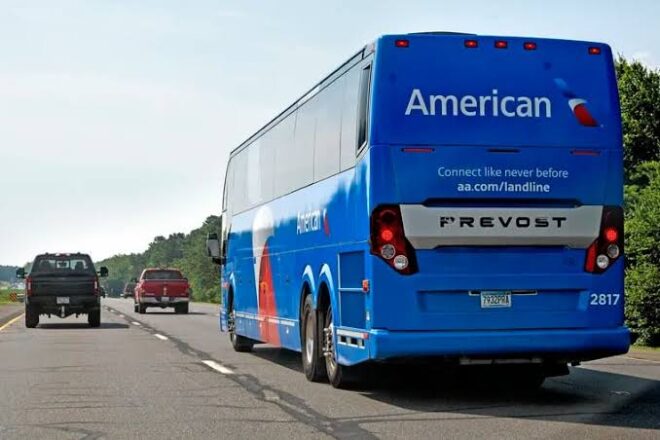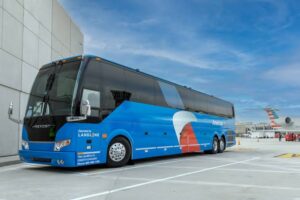
American Airlines Expands ‘Landline’ Bus Service: Bridging Wilmington Airport and PHL
In an era where convenience and seamless connectivity are paramount to travelers, American Airlines has stepped up to the challenge with its innovative expansion of the “Landline” bus service. This service, now linking Wilmington Airport (ILG) in Delaware with Philadelphia International Airport (PHL), offers a new dimension to regional travel, integrating bus and air transportation into a unified, user-friendly experience.

Introduction to the Landline Service
American Airlines first introduced the Landline service to eliminate some of the logistical headaches associated with regional air travel. The concept is simple yet ingenious: provide passengers with a single-ticket solution that covers both ground and air segments of their journey. This approach not only streamlines the travel process but also enhances accessibility to major hubs from smaller regional airports.
With the expansion to Wilmington Airport, American Airlines aims to address the specific needs of travelers in the Delaware Valley region, offering them a convenient and cost-effective alternative to reach Philadelphia International Airport, a major gateway with a vast network of domestic and international flights.
The Mechanics of the Landline Service
The Landline service operates as an integrated extension of American Airlines’ flight network. Here’s how it works:
Booking: Travelers can book their journey on the American Airlines website or through travel agencies, selecting Wilmington as their departure point and PHL as the hub for their connecting flight. The entire trip, including the bus and flight segments, is booked under a single reservation, simplifying the process for the traveler.
Check-In: Passengers have the convenience of checking in for their entire journey at Wilmington Airport. This means that both boarding passes and baggage handling are managed seamlessly, as if they were departing directly from a major airport.
The Bus Journey: The Landline buses are designed for comfort and efficiency, offering amenities such as Wi-Fi, power outlets, and spacious seating. The journey from Wilmington to Philadelphia is approximately 30 minutes, depending on traffic conditions, providing a swift and direct transfer.
At Philadelphia International Airport: Upon arrival at PHL, passengers are dropped off at their departure terminal, where they can proceed directly to security screening and onward to their flight. Checked baggage is automatically transferred, ensuring a hassle-free transition.
Benefits of the Service
The expansion of the Landline service to Wilmington Airport brings several advantages:
1.Increased Accessibility: For residents of Delaware and nearby regions, the service offers a direct link to one of the nation’s busiest airports without the need to drive or arrange separate ground transportation.
2. Cost-Effectiveness: By consolidating the bus and flight into a single ticket, travelers can often find more competitive pricing than booking each segment separately.
3.Environmental Impact: The Landline service potentially reduces the number of short-haul flights, which are less fuel-efficient compared to bus travel, thereby contributing to lower carbon emissions.
4.Convenience and Comfort: The ability to check baggage through to the final destination and avoid the stress of navigating a major airport on your own adds a layer of convenience that is highly appealing to travelers.
5.Enhanced Connectivity: The service opens up Wilmington Airport as a viable starting point for a broader range of travel itineraries, providing more options for travelers in the region.
Strategic Implications for American
Airlines
American Airlines’ decision to expand the Landline service reflects a broader strategic focus on enhancing regional connectivity and optimizing their route network. This approach allows the airline to tap into markets that may not justify frequent short-haul flights while still maintaining a presence and serving customer needs.
By integrating bus services with air travel, American Airlines is also diversifying its service offerings and creating new revenue streams. This model can potentially be expanded to other regions, providing a blueprint for connecting underserved areas with major air hubs.
Customer Experience and Feedback
Early feedback from passengers using the Landline service has been overwhelmingly positive. Many travelers appreciate the ease of booking a single ticket and the reassurance of having their luggage handled seamlessly. The comfort of the buses and the efficiency of the transfer process have also received praise, highlighting the potential for this service to become a preferred choice for many.
Challenges and Considerations
While the Landline service offers numerous benefits, there are also challenges to consider:
Traffic and Delays: Ground transportation is subject to traffic conditions, which can impact the punctuality of the service. American Airlines must ensure that there is ample buffer time between the bus arrival and flight departure to accommodate potential delays.
Awareness and Adoption: Educating travelers about the benefits and mechanics of the service is crucial to increasing adoption rates. Many travelers may not be aware of this option or may have concerns about the reliability of bus transfers.
Integration with Existing Operations: Ensuring a smooth integration of the Landline service with existing airport operations, including baggage handling and customer service, requires careful coordination and investment.
Future Outlook
The expansion of the Landline bus service to Wilmington Airport is a significant step forward in American Airlines’ mission to redefine regional travel. As the service gains traction, it has the potential to reshape how travelers view connections between smaller regional airports and major hubs.
Looking ahead, American Airlines may explore further expansions of the Landline concept to other cities and regions, particularly those where demand for short-haul flights is limited but where there is a strong desire for convenient access to larger airports.
Additionally, the success of the Landline service could inspire other airlines to adopt similar models, leading to a broader transformation in the industry. This shift towards integrated travel solutions reflects a growing recognition of the need for flexibility, convenience, and sustainability in modern travel.
Conclusion
American Airlines’ Landline bus service represents a forward-thinking approach to meeting the evolving needs of travelers. By connecting Wilmington Airport with Philadelphia International Airport, the airline is not only enhancing regional accessibility but also setting a new standard for how different modes of transportation can be integrated into a cohesive and customer-centric travel experience.
As the service continues to expand and evolve, it holds the promise of making air travel more accessible, affordable, and environmentally friendly for a broad range of travelers. In a world where efficiency and convenience are key, the Landline service is poised to play a pivotal role in shaping the future of regional transportation.